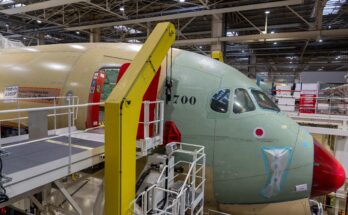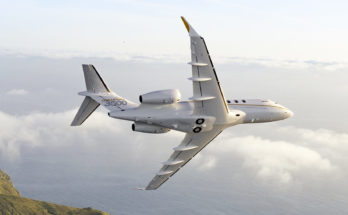AVIC is the Airbus, Boeing, and Lockheed Martin of China. The firm consolidates all of China’s aviation activities under its aegis in one form or another. The goal behind its formation is to transform China into a major aerospace power that can compete on a global stage. The effort appears to be working, as AVIC has been slowly improving its position. In 2019, AVIC ranked 151st among Fortune magazine’s Global Top 500, up 10 spots from 2018.
However, as can be expected from such a large entity, additional changes have been slow in coming. The most recent change occurred in 2016 with the formation of Aero Engine Corp of China (AECC). The majority of AECC’s operations were separated from AVIC, which now is centered on airframes and related systems. AVIC still has many non-aviation operations under its structure that could prove to be a distraction for the company. For example, the company finally divested its shipbuilding holdings in 2019.
In terms of aviation programs, AVIC works in close association with COMAC on two of China’s premier aircraft programs: the C919 narrowbody airliner and the ARJ21 regional jet.
The first C919 was rolled out in late 2015 and made its first flight in 2017. This all-new narrowbody airliner is designed to compete directly against the Airbus A320 family and the Boeing 737.
COMAC’s inexperience in testing and certificating civil airliners has led to a long, drawn-out flight test program. While COMAC may have gained experience through the long-delayed ARJ21 program, even highly experienced Airbus, Boeing, and Bombardier have trouble keeping to aggressive schedules with all‑new aircraft. Currently, COMAC expects service entry in 2021, but this new target is too optimistic. Indeed, an executive at one major Western supplier has suggested that a more realistic date for service entry is in the 2025-2030 time period.
Nevertheless, the program represents a milestone for China. One advantage the C919 program possesses over Western competitors is that it is largely insulated from the financial pressures placed on Western manufacturers. The Chinese government wants to build an indigenous capability to produce airliners that are competitive with those built by Western companies. Therefore, the program will continue for as long as the Chinese government wants, regardless of whether the aircraft racks up major sales from airlines outside China.
As AVIC continues to develop itself as a manufacturer, the company is recognizing its limitations, which include a lack of experience, aviation talent, and infrastructure. Because AVIC seeks to become more of a developer than a duplicator, the need for outside technical acumen is acute. Over the past decade, AVIC has been filling these technological gaps with teaming arrangements or outright acquisition of niche firms.
The company has successfully teamed with Western manufacturers such as Bombardier, Parker Aerospace, and Safran to help educate its operations. Not only do these partnerships help in the here and now, but they will also plant the seeds for future collaboration. It is this long view that will help guide AVIC’s strategy to eventually become a world-class aircraft developer.
In addition, the company has complemented and expanded its international footprint with acquisitions. Most recently, the firm acquired AIM Altitude, a manufacturer of aircraft interiors, and Aritex, a riveting systems specialist. These two operations add to AVIC’s growing international footprint, which includes Fischer Advanced Composite Components (FACC) and Thielert in Europe and four acquisitions in the United States: Continental Motors, Epic Air, Cirrus Aircraft, and Align Aerospace.
These acquisitions are of major importance to AVIC, as they provide the firm with access to advanced foreign technologies that can be exploited under China’s well‑established civil-military integration strategy. The company is targeting small to midsize operations with technological capabilities in the commercial aerospace sector. These skills will be leveraged into the firm’s current civil aircraft programs, then incorporated into military spheres.
Currently on AVIC’s acquisition target list is Bombardier’s Belfast operation. In May 2019, Bombardier announced it would pursue the divestiture of the Belfast and Morocco aerostructures businesses. The sales are part of the company’s effort to optimize its global manufacturing footprint. Airbus has expressed interest in acquiring Bombardier’s A220 wing production plant in Belfast. Aerostructure specialists GKN, Triumph Group, and Spirit AeroSystems may also be interested in the operations.
This flurry of acquisition activity has caused some concern in the U.S., where AVIC’s deals have been heavily scrutinized and criticized. While the deals were ultimately approved, Congress voiced concerns that AVIC would adapt some of the technologies for weapons systems and/or transfer work to China. China has made no secret that it is looking to improve its military technology and sees the adoption of civil technology as a means to this end.
With the Trump administration’s current animosity toward China, future activity in the U.S. is unlikely in the near term. Adding to the concerns is that the company is seeking to gain access to major aerospace manufacturers through the acquisition of minority stakes. The purchases of smaller manufacturers have already established inroads for the firm in U.S. aerospace supply chains. In light of recent allegations against Chinese tech giant Huawei, AVIC could find itself in a similar position should it push too hard into U.S. markets.
A military history enthusiast, Richard began at Forecast International as editor of the World Weapons Weekly newsletter. As the Internet grew in importance as a research tool, he helped design the company's Forecast Intelligence Center and currently coordinates the EMarket Alert newsletters for clients. Richard also manages social media efforts, including two new blogs: Defense & Security Monitor, covering defense systems and international issues, and Flight Plan, which focuses on commercial aviation and space systems. For over 30 years, Richard has authored the Defense & Aerospace Companies, Volume I (North America) and Volume II (International) services. The two books provide detailed data on major aerospace and defense contractors. He also edits the International Contractors service, a database that tracks all the contractors involved in the programs covered in the FI library. More recently he was appointed Manager, Information Services Group (ISG), a new unit that encompasses developing outbound content for both Forecast International and Military Periscope.




